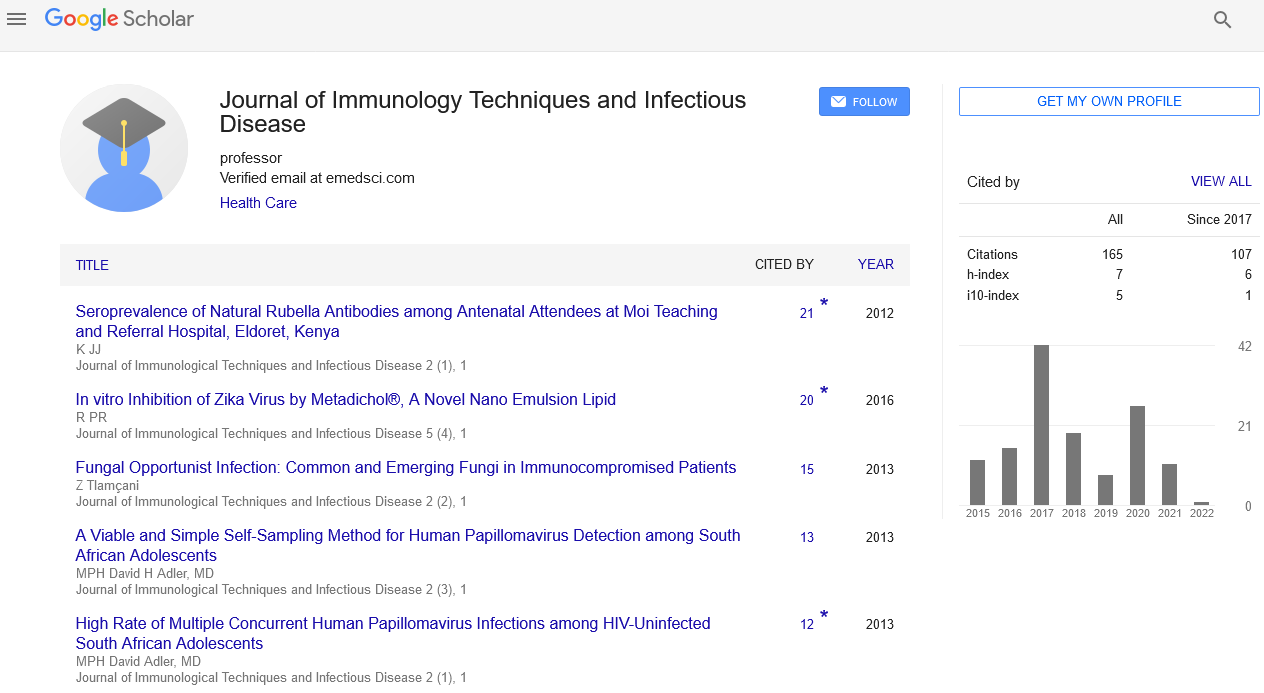Case Report, J Immunol Tech Infect Dis Vol: 5 Issue: 1
Rapid Identification by MALDITOF of Neisseria elongata Subspecies nitroreducens in an Endocarditis Case
| Fasciana T1, Di Gaudio F2, Novo S3, Aquilina G1, Indelicato S2, Giordano G1, Parrinello R3, Bonura C1, Calà C1 and Giammanco A1* | |
| 1Department of Science for Health Promotion and Mother-Child Care "G. D'Alessandro”, Unit of Microbiology, University of Palermo, Via del Vespro 133, 90127 Palermo, Italy | |
| 2Mass Spectrometry Laboratory for Clinical Risk and Quality Control, A.O.U.P. “P. Giaccone”, University of Palermo, Italy | |
| 3Department of Science for Health Promotion and Mother-Child Care "G. D'Alessandro”, Unit of Cardiology, University of Palermo, Via del Vespro 133, 90127 Palermo, Italy | |
| Corresponding author : Anna Giammanco Full Professor, Department of Sciences for Health Promotion and Mother and Child Care, GD Alessandro, University of Palermo, Via del Vespro 133, 90127 Palermo, Italy Tel: +39-091-6553678; Fax: +39-091-6553676 E-mail: anna.giammanco@unipa.it |
|
| Received: November 13, 2015 Accepted: February 26, 2016 Published: March 05, 2016 | |
| Citation: Fasciana T, Novo S, Gaudio FD, Aquilina G, Indelicato S, et al. (2016) Rapid Identification by MALDI-TOF of Neisseria elongata Subspecies nitroreducens in an Endocarditis Case. J Immunol Tech Infect Dis 5:1. doi:10.4172/2329-9541.1000137 |
Abstract
Rapid Identification by MALDITOF of Neisseria elongata Subspecies nitroreducens in an Endocarditis Case
Neisseria elongata subspecies nitroreducens is considered to be an important pathogen responsible for infective endocarditis, even if it is infrequently reported. We report the first case of endocarditis in Italy due to N. elongata subsp. nitroreducens.
Keywords: MALDI-TOF; Neisseria elongate; Endocarditis
Keywords |
|
| MALDI-TOF; Neisseria elongate; Endocarditis | |
Introduction |
|
| Since 1990 N. elongata subsp. nitroreducens has been recognized as the most virulent one of N. elongata subspecies, in fact the majority of 20 described cases of endocarditis are related to subspecies nitroreducens [1]. The endocarditis cases usually associated with N. elongata occur in the third decade of life, mostly with apparent cardiac or dental risk [2]. | |
| N. elongata subsp. nitroreducens , a commensal of human nasopharyngeal, has been described as responsible for endocarditis cases [2]. Among the three N. elongata subspecies, N. elongata subsp. elongata , subsp. glycolytica and subsp. nitroreducens, the subsp. nitroreducens has been recovered most frequently in cases of N. elongata endocarditis [3]. The infection is often associated with acute febrile endocarditis with large vegetation and a destructive process that frequently causes severe cardiac disease as well as various systemic complications [4]. | |
| Cases of endocarditis induced by N. elongata subsp. nitroreducens in patients without any apparent cardiac complication and risk factors have been also recently published [5]. | |
| The recent report of cases of infective endocarditis linked to N. elongata subsp. nitroreducens responsibility in patients without any serious underlying diseases raise the pathogenic infective role of the microorganism [1]. | |
| Since serious complications to microorganism infection have been described, even though no data associated with death have been reported, a close follow-up of these cases should be managed. | |
| Further studies representative of precise subspecies identification and proper protocols for antibacterial treatment are expected [1]. | |
| To prevent the evolution versus major complication adequate antibiotic therapy has to be administered. It is effective when a correct and rapid identification is performed [6]. | |
| To identify the microorganism, the phenotypic methods are considered equivocal; the use of 16S rDNA sequencing has been described as complementary technique to phenotypic method, especially in case of difficult identification [7]. | |
| We report a first case of endocarditis caused by N. elongata subsp. nitroreducens that occurred in Italy and was rapidly identified by means of mass spectrometry (MALDI-TOF). | |
Case Report |
|
| A 40-year-old male affected by Marfan syndrome with a prosthetic aortic valve and an ascending aortic graft placed in 1991 was admitted to the Operative Unit of Cardiology for evaluation of fever (temperature up to 39oC). The patient had had a fever for a week which had been resistant to antibiotic therapy. | |
| On admission, the patient’s blood pressure was 130/60 mmHg, his pulse rate was 100 beats per minute. His abdomen was soft and mildly tender in response to palpation throughout, without rebound. His laboratory results were notable for white blood cell count of 7.15 x 103/μL with 89.6% polymorph nuclear cells, 4.1% lymphocytes, 0.6% monocytes, 0.3% eosinophil and a hemoglobin level of 14.2 g/dL. Blood tests demonstrated elevation of C-reactive protein >74.9 mg/dL, creatinine phosphokinase< 33 U/L and lactate dehydrogenase 485 U/L. A trans esophageal echocardiogram (TEE) showed an echo lucent zone around the graft and vegetation on the prosthetic valve. Three sets of blood cultures were performed (BD BACTEC plus Aerobic/F, Plus Anaerobic/F and Mycosis-IC/F, BACTECTM Becton Dickson). | |
| Subsequently the patient was treated with empirical therapy with amoxicillin-clavulanic acid (1 g every 8 hours) and Gentamicin (80 mg every 8 hours) according to 2015 ESC Guidelines for the management of infective endocarditis [8]. | |
| Within 24 h three aerobic bottles were positive, the Gram stain showed a Gram negative bacillus quickly identified as N. elongata subsp. nitroreducens by MALDI-TOF. | |
| Subcultures were performed, and growth was observed after 24 hours of incubation with 5% CO2 on plates containing chocolate and blood agar. The colonies were small and not pigmented. No hemolysis on sheep or horse blood was observed. The organism was strictly aerobic, catalase negative and oxidase positive. To identify this Gramnegative short rod with good agreement, we used the technique of MALDI-TOF confirmed by a molecular approach based on 16S ribosomal RNA gene sequencing. | |
| To identify the three positive sets of blood culture, the Bruker Sepsityper kit (Bruker Daltonics, Germany) was used according to the manual of instruction, and proteins were extracted using equal volumes of 70% acetonitrile and formic acid. The extracts were centrifuged (10,000 x g, 2 min), and final supernatants were spotted onto a 96-well ground steel target plate and overlaid with 1 μL of α- cyano-4-hydroxycinnamic acid matrix solution (both from Bruker Daltonics, Germany). After drying, samples were subjected to analysis using a Bruker Auto flex speed system according to the manufacturer’s recommendations. The resulting spectra were analyzed with Bruker Biotype 3.0 software using a reference spectrum library with bloodculture- specific parameters that excluded mass peaks with m/z ratios of <4,000. Identification scores of 1.6 to <1.8 were considered valid to the genus level, scores of 1.8 to 3.0 were considered valid to the species level, while scores of ≤1.6 were considered invalid [9]. The bacterium was identified as N. elongata subsp. nitroreducens with a score of 2.07. | |
| To confirm the identification of the isolate, a molecular approach based on 16S ribosomial RNA gene sequencing was used. A 1,487-bp fragment of the 16S ribosomial RNA gene was amplified by PCR with primers forward (5’-AGTTTGATCCTGGCTCAG-3’) and reverse (5’- GG TTACCTTGTTACGACTT-3’) (Eurobio, Les Ulis, France). Automated sequencing of the purified PCR product was performed on the two strands with the Big Dye terminator kit (Applied Biosystems), and the sequence was analyzed with an ABI PRISM 310 genetic analyzer (Applied Biosystems). The sequence was aligned by giving 100% homology to that of N. elongata subsp. nitroreducens GeneBank accession number (GenBank accession number KT591873). | |
| The antibiotic susceptibility of the strain was tested by the disk diffusion method on Mueller-Hinton agar (Bio-Rad, Marnes-la- Coquette, France) incubated at 37oC for 24 h and interpreted according to the CA-SFM criteria. | |
| The microorganism showed reduced sensitivity to Clindamycin but was fully sensitive to Cefalotin, Cefotaxime, Ceftazidime, Ciprofloxacin, Cloramphenicol, Gentamicin, Ofloxacin, Tetracicline and Trimethoprim/Sulfamethoxazole. | |
| Soon after administration of targeted therapy (Ceftazidime 2 g every 8 hours and Gentamicin 80 mg every 8 hours) the patient became apyretic and he remained so throughout the entire clinical course; the C reactive protein level greatly decreased. | |
| After clinical and laboratory remission, on hospital day 21 the patient was discharged in good condition. The antibiotic therapy (intramuscular Gentamicin and intramuscular Ceftazidime) was continued at home for other three weeks. | |
| A transthoracic echocardiography, performed one month after hospital discharge, showed complete resolution of the vegetation. | |
Conclusion |
|
| To the best of our knowledge, more than 20 cases of N. elongata endocarditis have appeared in the literature; we present the first case of endocarditis in Italy due to N. elongata subsp. nitroreducens and its identification in a short time by MALDI-TOF. | |
| In our experience the correct identification was rapidly obtained by use of mass spectrometry directly from positive blood culture. The use of MALDI-TOF method allowed us to obtain shortly the exact classification of an unusual isolate, as demonstrated by molecular and phenotypic characterization | |
Nucleotide Sequence Accession Number |
|
| The amplified production including 1416 nucleotides of the 16S rRNA gene of N. elongata subsp. nitroreducens was deposited in Gen Bank under accession number KT591873. | |
Acknowledgements |
|
| We would like to express our gratitude to: Dr. Salvatore Distefano, Rossella Spina and Heidrun Aschacher for their technical support. | |
References |
|
|
 Spanish
Spanish  Chinese
Chinese  Russian
Russian  German
German  French
French  Japanese
Japanese  Portuguese
Portuguese  Hindi
Hindi 
